
Considered the "national food tuber" in the late 1970s, potatoes played an important role in supplementing people's food sources, especially at a time when agriculture was still limited in productivity and mechanization.
However, like many other crops that were once favored, potatoes gradually gave way to other crops with higher crop yields. Only able to be grown once a year, the variety quickly degenerated, requiring high technical requirements, and unstable output - potatoes quietly withdrew from the main role, becoming a secondary crop in some small areas.
But the transformation of Vietnamese potatoes began with an unexpected turning point: When potatoes were no longer just for fresh consumption, but became industrially processed ingredients, serving the snack and potato chip production chain according to global standards.
Farmers' income increases 3-4 times compared to rice cultivation, opening up a direction for sustainable development in many specialized areas across the country.
Behind this success is a strong triangle: Farmers - Scientists - Businesses.
In the conversation between Dan Tri reporter and Associate Professor, Dr. Nguyen Xuan Truong - Director of the Institute of Agricultural Biology, the 15-year journey of transformation of Vietnamese potatoes was clearly shown: From the laboratory to the field, from a model of a few hectares to more than 1,000 hectares of growing areas across the country.
Not only contributing to improving the quality of potatoes, the Institute is also "cultivating" a modern agricultural production mindset - methodical, chain-based, based on data and markets.

Sir, among the many valuable crops in Vietnam, why did the Institute of Agricultural Biology choose potatoes as the subject of in-depth and long-term research, instead of popular crops such as rice, corn or vegetables?
- We need to go back to the story of potatoes in the past. Potatoes were brought to Vietnam by the French.
Around 1979-1980, when our economy was in a difficult period, potatoes were grown on an area of more than 100,000 hectares - a very large number under the conditions at that time.
If each hectare had yielded just 10 tons, the whole country would have had over a million tons of food, enough to supplement the meals of millions of people. At that time, rice productivity was still low, and rice had to be imported. And it was potatoes that helped many regions overcome that difficult period.
However, the very plant that once saved the day is gradually being forgotten in modern production structures.
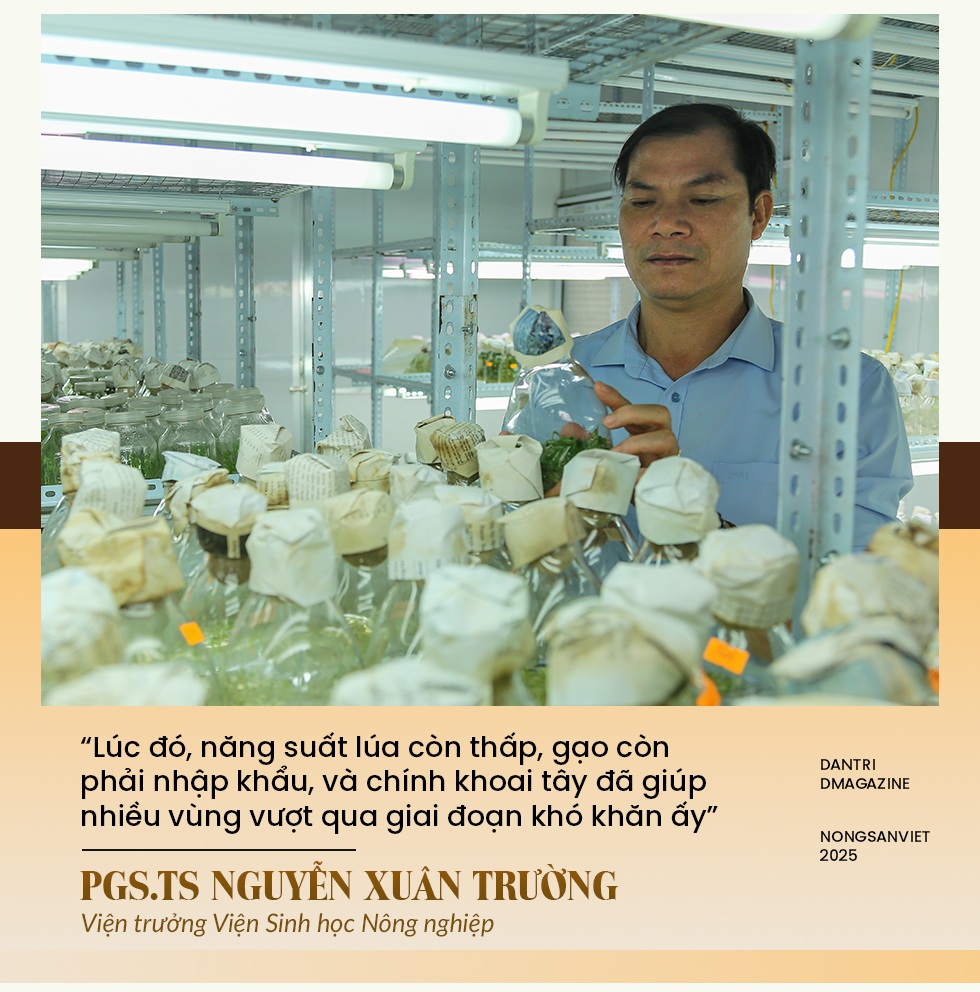
This is an unfortunate reality, but it is also understandable from a technical and economic perspective. Potatoes are cold-loving crops, can only be grown once a year, have a long seed rotation period and a very low multiplication coefficient. Meanwhile, rice can be grown twice, corn can be grown three times - obviously the seasonal efficiency is lower.
Not to mention, potato varieties degrade very quickly, each year of reuse the quality has decreased significantly. Without a proper breeding process, maintaining the quality of the variety is almost impossible.
As agricultural land gradually shrinks due to industrialization, young people leave the countryside to work in industrial zones, potatoes - which require high care techniques and large initial investments - are no longer a popular choice among farmers.
Another problem is the lack of stable output. People can grow potatoes on a small scale of a few acres and then sell them at the market, but if they expand to dozens of hectares, there will be no factory to buy them long-term. Without businesses and contracts, potato production can easily fall into the situation of "good harvest, low price".
Therefore, despite once playing a major role in food security, potatoes have gradually fallen off the map of key agricultural products, only remaining quietly in a few localities with a long tradition of growing them.
However, from the perspective of agricultural science, we believe that potatoes have many benefits and potentials. In addition to their food value, they can also be used as animal feed, do not compete with rice - the main crop, but even support soil improvement, contributing to crop diversification.
With the above favorable natural conditions, deep processing potential from enterprises and available research capacity, we believe that potatoes can completely become a high-value agricultural commodity of Vietnam.
And in fact, the Institute of Agricultural Biology has had a long tradition of researching potato varieties, since I was a student and learned and inherited potato breeding technology from previous generations of teachers.
My colleagues and I continue to develop in an industrial direction, applying aeroponics and tissue culture technology to serve large-scale production, reduce import dependence, bring high economic value and proactively provide plant varieties for Vietnam.
What turning point helped potatoes return to the map of key agricultural products, but this time with the goal of serving the processing industry?
- I still remember that time very clearly - in 2007, when Orion Group (Korea) came to our potato experimental model in Yen Phong, Bac Ninh.
They found the work to be carried out very methodically and seriously.
They did not come with an invitation to cooperate right away, but brought along some foreign potato varieties for testing. We received them, cared for them, and monitored them closely. The results were better than expected. That was when the official meeting with the Institute was opened.
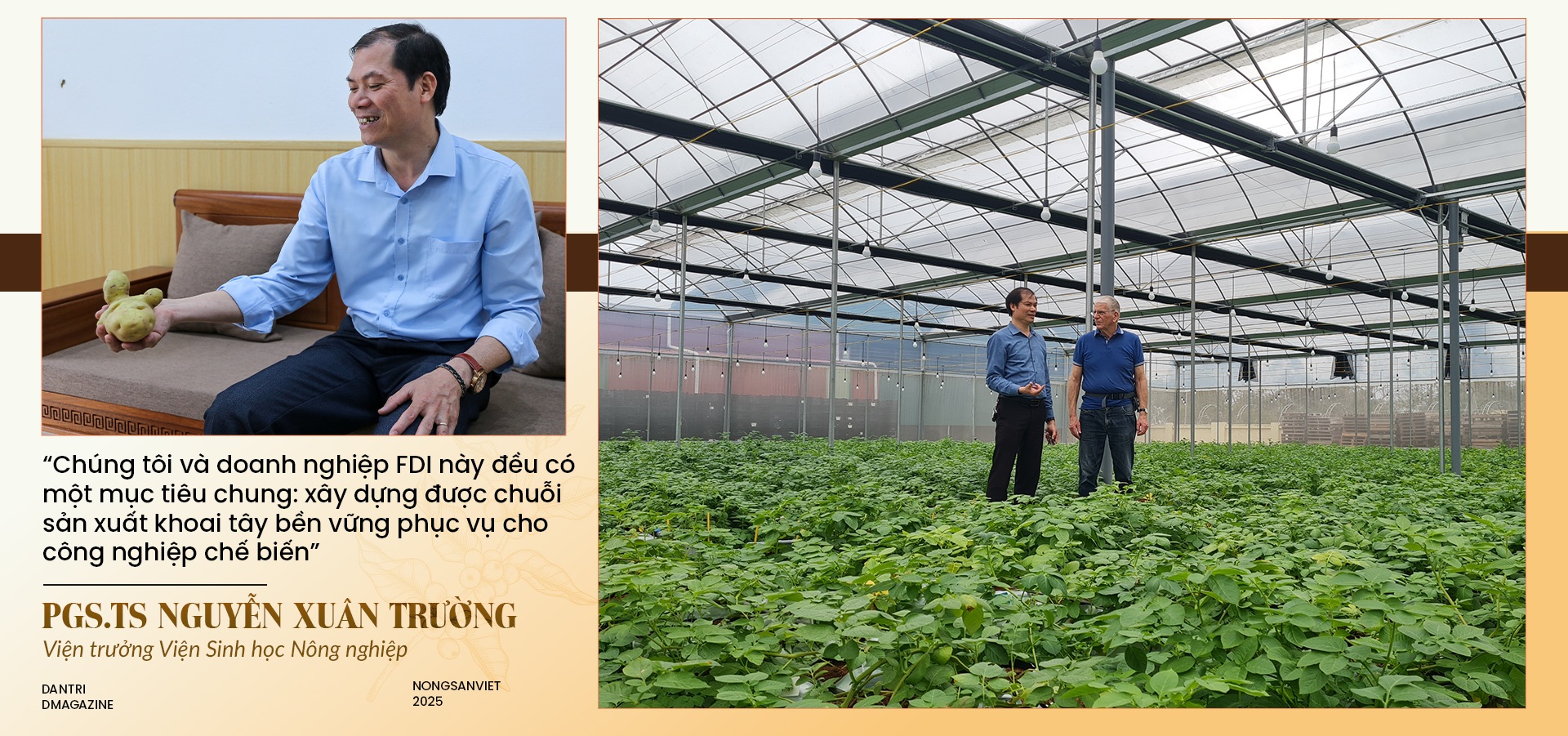
At that time, Prof. Dr. People's Teacher Nguyen Quang Thach, who was the Director of the Institute of Agricultural Biology, directly received the delegation. That meeting opened the first cooperation between the two sides. Orion needed a research partner with in-depth expertise, the ability to expand the model and connect with localities.
We and this FDI enterprise have a common goal: to build a sustainable potato production chain to serve the processing industry - specifically the production of snacks and potato chips according to global standards.
What they need is a potato variety of uniform quality, round tubers, not green, not cracked, white flesh, high dry matter content - very strict requirements that local varieties cannot meet.
Abroad, agricultural processing enterprises often cooperate closely with research and higher education institutions to build sustainable value chains. This group also aims for such a model, and we have consensus right from the first exchanges.
In 2007, the cooperation project officially started with a scale of only 5 hectares. This was the "opening shot" for a journey of more than 15 years to build a high-tech potato chain in the direction of industrial processing in Vietnam.
After nearly two decades, that scale has been expanded into a large, stable, and sustainably developed network of raw potato growing areas.
From a few initial experimental hectares in Hai Phong, we began to build a pilot model, from varieties - planting process - care techniques - to linking with cooperatives.
The first steps of this journey must not be easy?
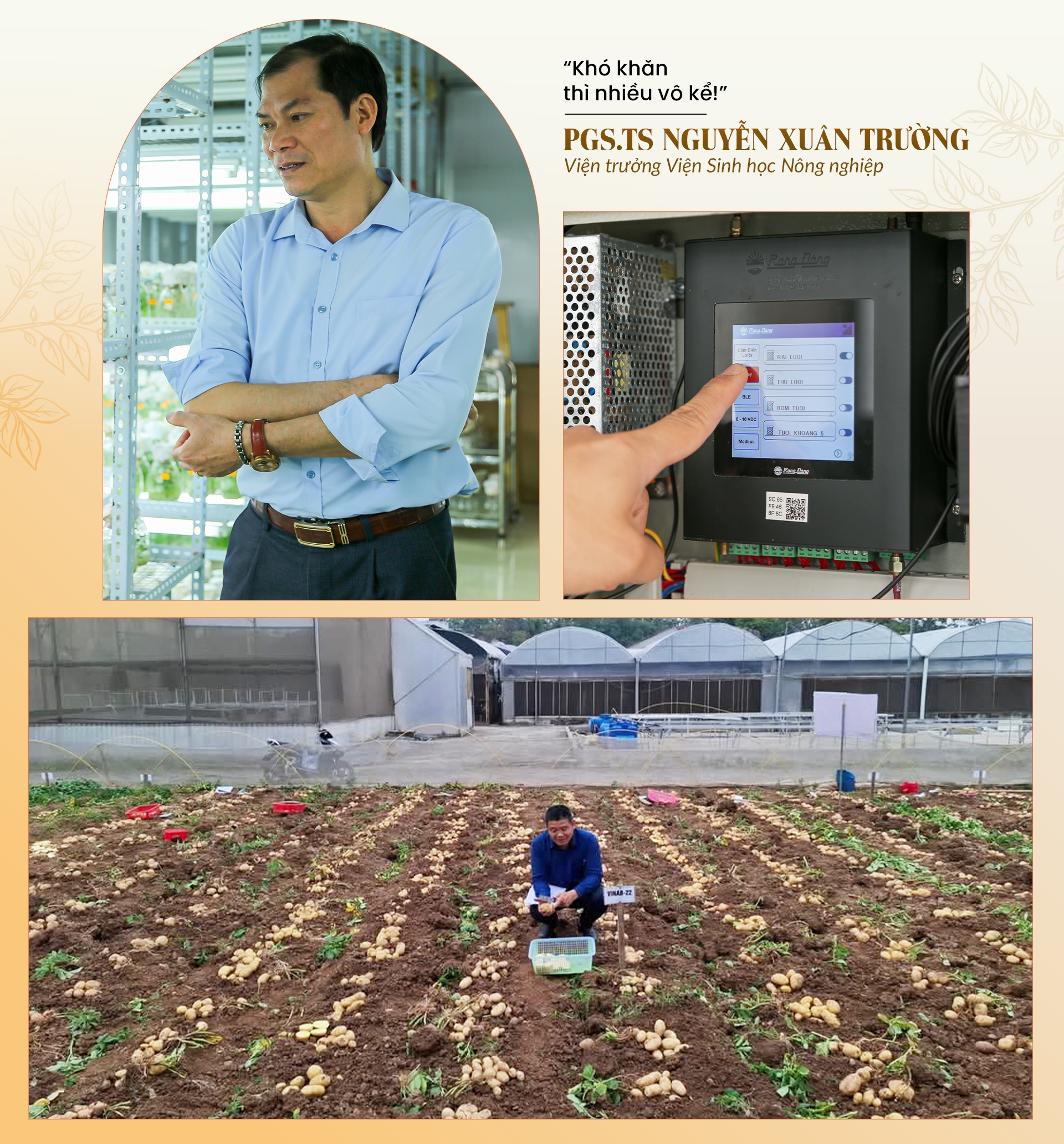
- There are countless difficulties!
First, there is the issue of weather conditions. Potatoes are a cold-loving crop, while weather conditions in Vietnam, especially in the North, are changing quite clearly. The average temperature is increasing, causing the natural growth time of potatoes to be shortened.
We have to research how to make the plant varieties better adapted to weather conditions, including warm days in winter.
Second is the growing area. Most localities have never grown potatoes using industrial processes. People are used to growing a few acres for fresh food, and have no idea what it means to grow potatoes for a factory.
Third, people are afraid of change. Many farmers still stick to old habits and are afraid to try new varieties, especially when they do not see a stable output or immediate economic efficiency. To convince people to use high-quality varieties, it is necessary to have the participation of businesses, local authorities and especially agricultural cooperatives.
Fourth, the crop structure and changes in agricultural labor. In the North, the common farming model is "2 rice crops, 1 winter crop", and the winter crop is the only time to grow potatoes. However, the spring crop often has to be sown early, so the time for potato plants is limited. We have to research potato varieties with a shorter growing period but still ensure productivity and quality.
Fifth, there is a change in the structure of rural labor. There are fewer and fewer young people working in agriculture, and the production force is mainly elderly or seasonal workers. This forces us to consider mechanization solutions, forming large production areas, and applying high technology to reduce manual labor while still increasing productivity.
Sixth, there are differences in farming practices between regions. Each locality has its own way of doing things, different soil and climate conditions, so it is difficult to apply a general process. This requires us to adjust the techniques to suit each region and each specific condition, which takes a lot of time and effort.
All these challenges are the motivation for the Institute of Agricultural Biology to continuously improve techniques, apply technologies such as aeroponic propagation, tissue culture, and closely cooperate with businesses to ensure output for farmers.
How did the first trial crop turn out?
- In 2008, the first trial crop was planted on 5 hectares in Hai Phong. The yield in the field was very good, but when harvested and brought to the factory, the standard rate was extremely low. The tubers were uneven, not the right size, and had green skin...
Businesses have agreed to raise purchase prices to help farmers cover losses - and keep faith for the next crop.
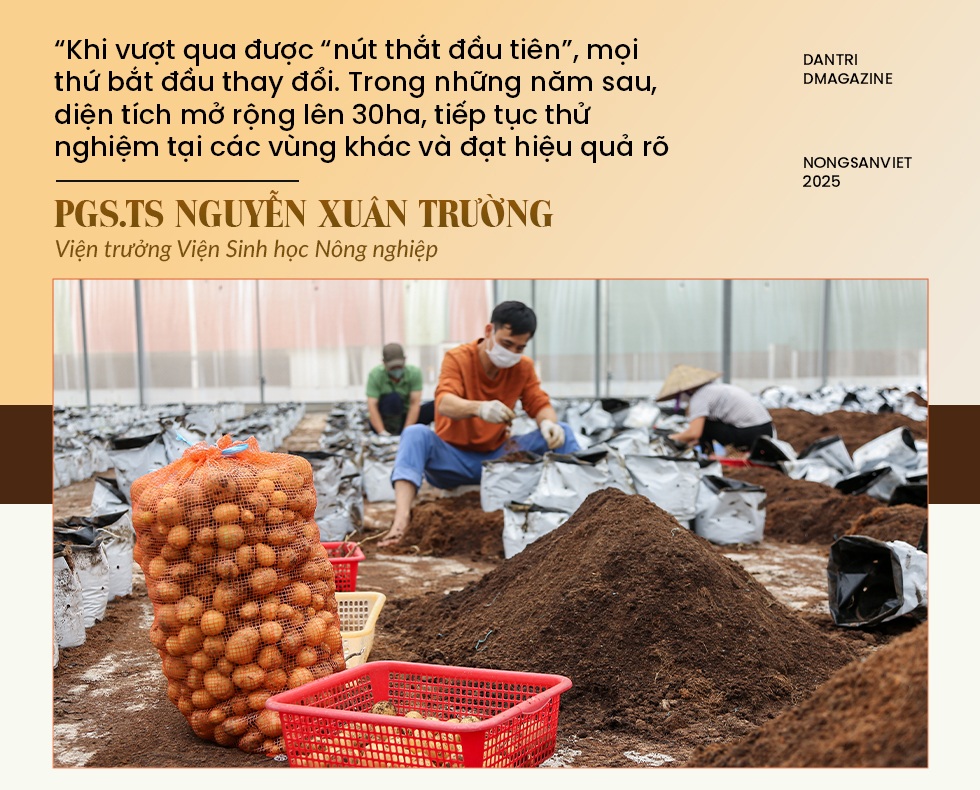
However, the good news is that local authorities have been very active in supporting people to access new varieties and convert production.
Once the “first bottleneck” was overcome, things began to change. In the following years, the area was expanded to 30 hectares, continued to experiment in other areas and achieved remarkable results. Currently, Tien Lang (Hai Phong) is a very stable production area with over 70 hectares, productivity and quality among the highest in the North.

As you shared, varieties were a bottleneck for potatoes in the past. How did the Institute of Agricultural Biology solve this problem?
- This is an extremely important step. Seeds have been the "bottleneck" of potatoes for many years. Imported seeds are expensive, not well adapted, and cannot be proactively timed. Each planting season is only once a year, if it is delayed by a week, the whole crop is considered lost.
We flexibly combine many methods, from traditional to modern. First, we use traditional breeding to create new hybrid combinations, then we conduct selection and evaluation in greenhouse systems and in the field. Thanks to that, the selection time is significantly shortened.
To maintain the original breed and multiply quickly, we use tissue culture technology. Thanks to that, we can reproduce in conditions of complete control over temperature, light, and humidity. Tissue culture helps to reproduce all year round, maintaining purity and disease-free.
Another breakthrough is aeroponics technology. In a closed greenhouse, seedlings are fed with nutrient solution without soil. Unlike tissue culture which is done in a closed room, aeroponics takes advantage of natural light, plants grow stronger and faster. In particular, the multiplication coefficient is 25 times higher than the old method.
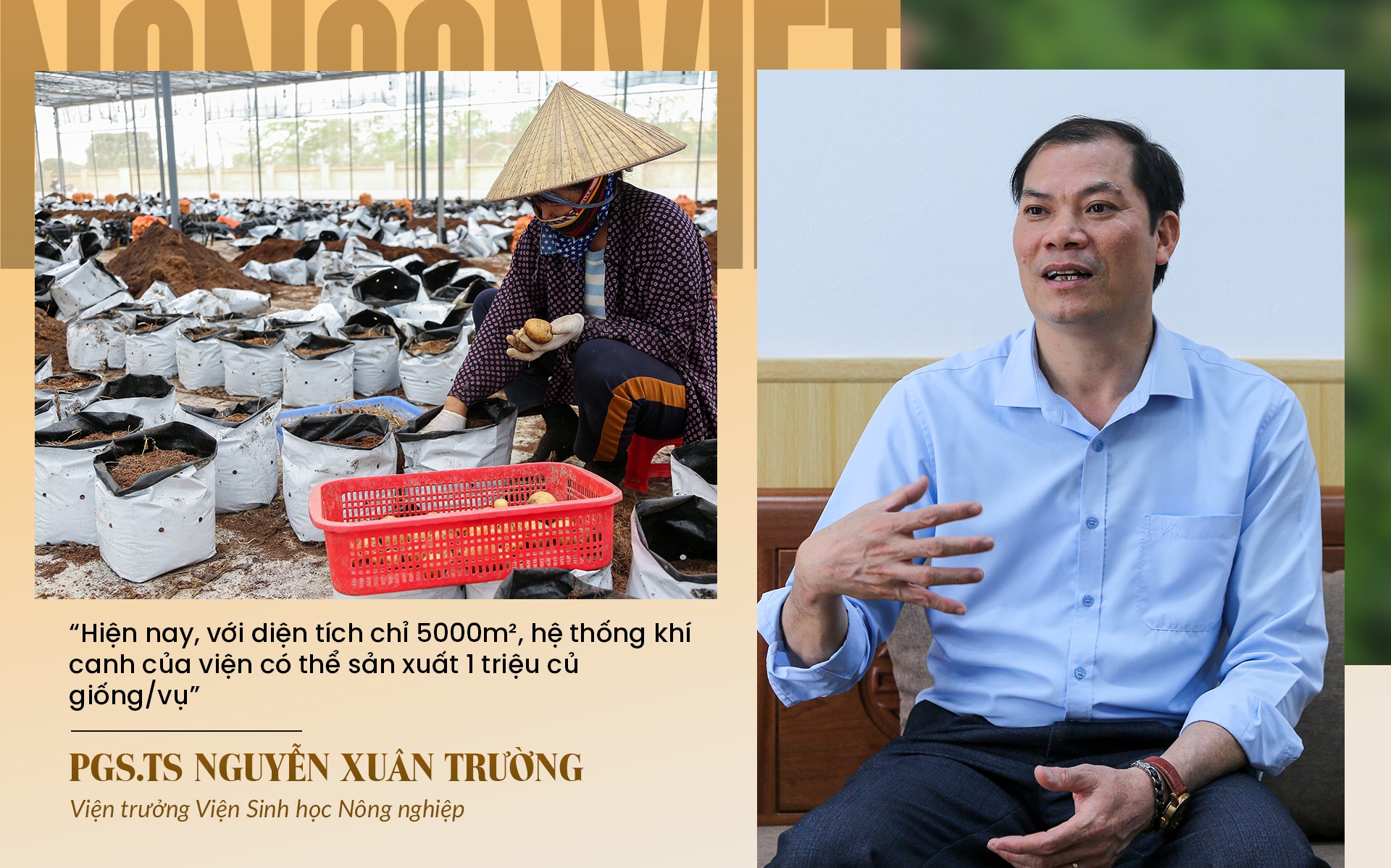
Currently, with an area of only 5,000m², the institute's aeroponic system can produce 1 million bulbs/crop.
We also build a three-level process: super pure - pure - certified, to ensure that field crops have stable, uniform quality, meeting standards for industrial processing.
All of these steps help us to be completely proactive in domestic potato varieties, gradually escape dependence, improve productivity and expand growing areas sustainably.

After mastering the breed, did the Institute encounter any difficulties in expanding the growing area? And how far has the scale of breed production and raw material areas developed?
- There was a time that we jokingly called "the paradox of success" - when businesses continuously placed orders, but we did not have enough seeds to sell, and people did not have enough land to grow more.
From a trial crop of only 5 hectares in 2008, the total area of potato cultivation using varieties produced by the Institute has now reached more than 1,000 hectares, stretching from the North to the Central Highlands. Of which, Tien Lang (Hai Phong) is the most stable growing area with productivity and quality among the highest in the country. In the Central Highlands, some localities have achieved productivity of up to 53 tons/ha, 3 times higher than before.
Along with the expansion of the growing area, the Institute’s seed production capacity has also skyrocketed. Before 2015, each crop only produced about 500 tons of certified seeds, but now it has exceeded 1,000 tons. The new varieties are not only disease-free and high-yielding, but also meet industrial standards.
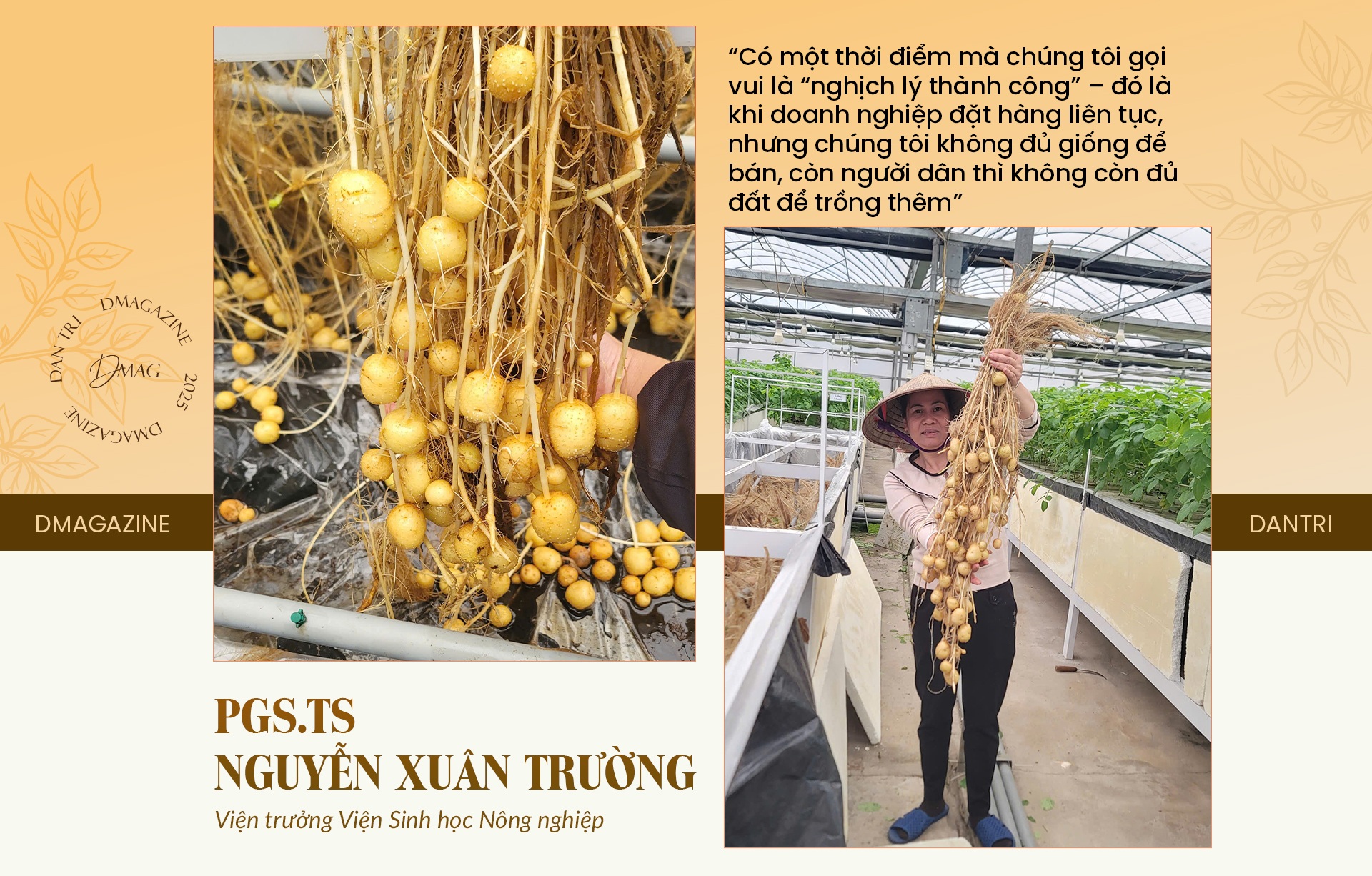
We also cooperate with cooperatives to organize regional farming models - with training, technology transfer and quality monitoring. Thanks to that, the rate of qualified products brought into the factory has increased significantly, minimizing risks for people, and especially creating a truly closed agricultural value chain.
This is the result of a process of continuous research and improvement, as well as close coordination between scientists - businesses - farmers.

With potatoes, how has the application of new varieties, advanced techniques and the shift towards providing raw materials for the processing industry changed farmers?
- It can be said that economic efficiency is the factor that makes the potato growing model spread strongly in recent years. The numbers speak for themselves, and people see that very clearly.
In the North, the institute's white potato variety has an average yield of 25 tons/ha. After deducting investment costs, farmers can earn a profit of 70 to 100 million VND/ha.
In the Central Highlands, the yield reaches 53 tons/ha. A household growing 1ha of potatoes can earn about 500 million VND, after deducting 250 million VND in expenses, the net profit is about 250 million VND. Many households grow 3-4 hectares, the total profit reaches 700-800 million VND/crop, which is completely realistic.
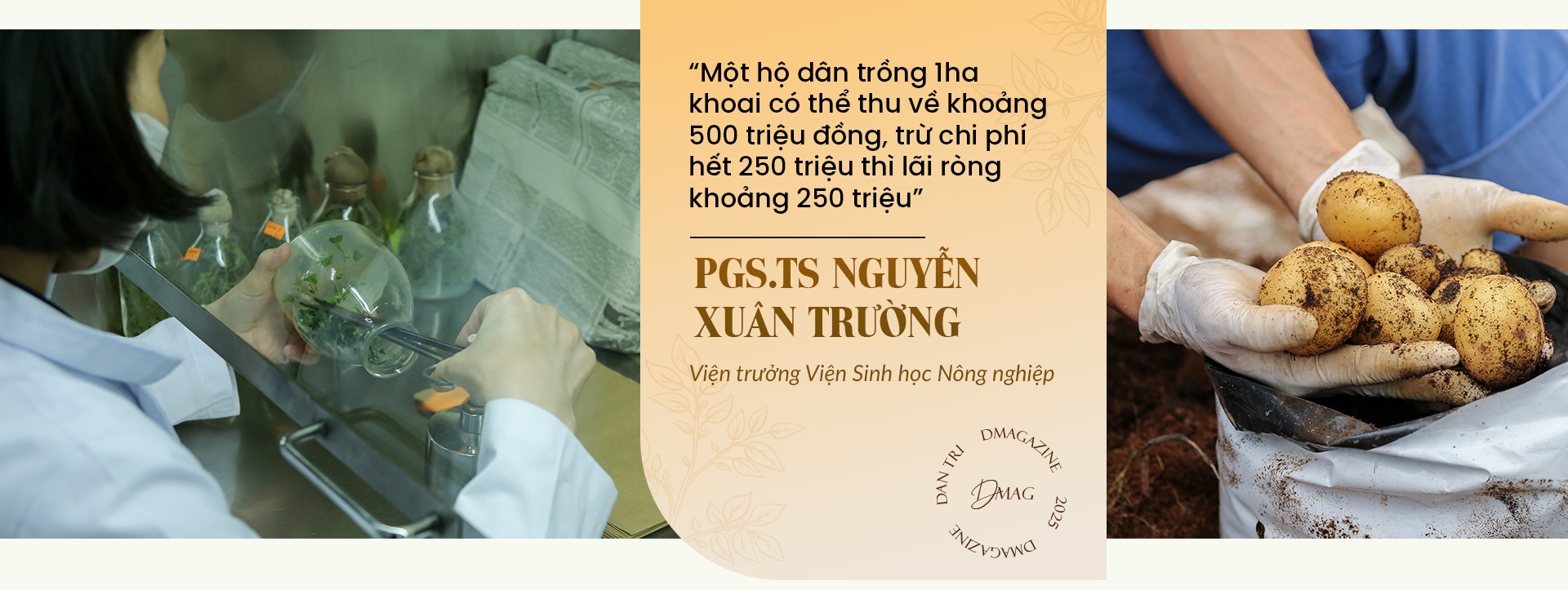
Not only productivity increases, but quality is also stable, output is guaranteed thanks to the connection with businesses. Businesses are even willing to share risks if the weather is unfavorable.
The difference also comes from production thinking. In many localities such as Dong Trieu (Quang Ninh), Tien Lang (Hai Phong) or districts in the Central Highlands, farmers are familiar with the concept of "growing potatoes for factories", using certified seeds, applying mechanization and synchronous processes.
Each commune can develop hundreds of hectares of raw material areas, farmers' income increases significantly, and life improves every year.

Looking back on the journey, what plans does the Institute of Agricultural Biology have for the future? How can Vietnamese potatoes not only be a model but also become a symbol of modern agricultural production thinking?
- Definitely yes. First of all, the issue of raw materials and plant varieties is the core issue, we need to continue to search and improve to create potato varieties that are more suitable for conditions in Vietnam.
Second, the Institute is promoting the application of digital technology in crop monitoring: building software to monitor growth, provide early warning of pests and diseases, and analyze soil nutrients in real time. With the support of technology, farmers can proactively prevent risks and improve farming efficiency without relying too much on manual experience.
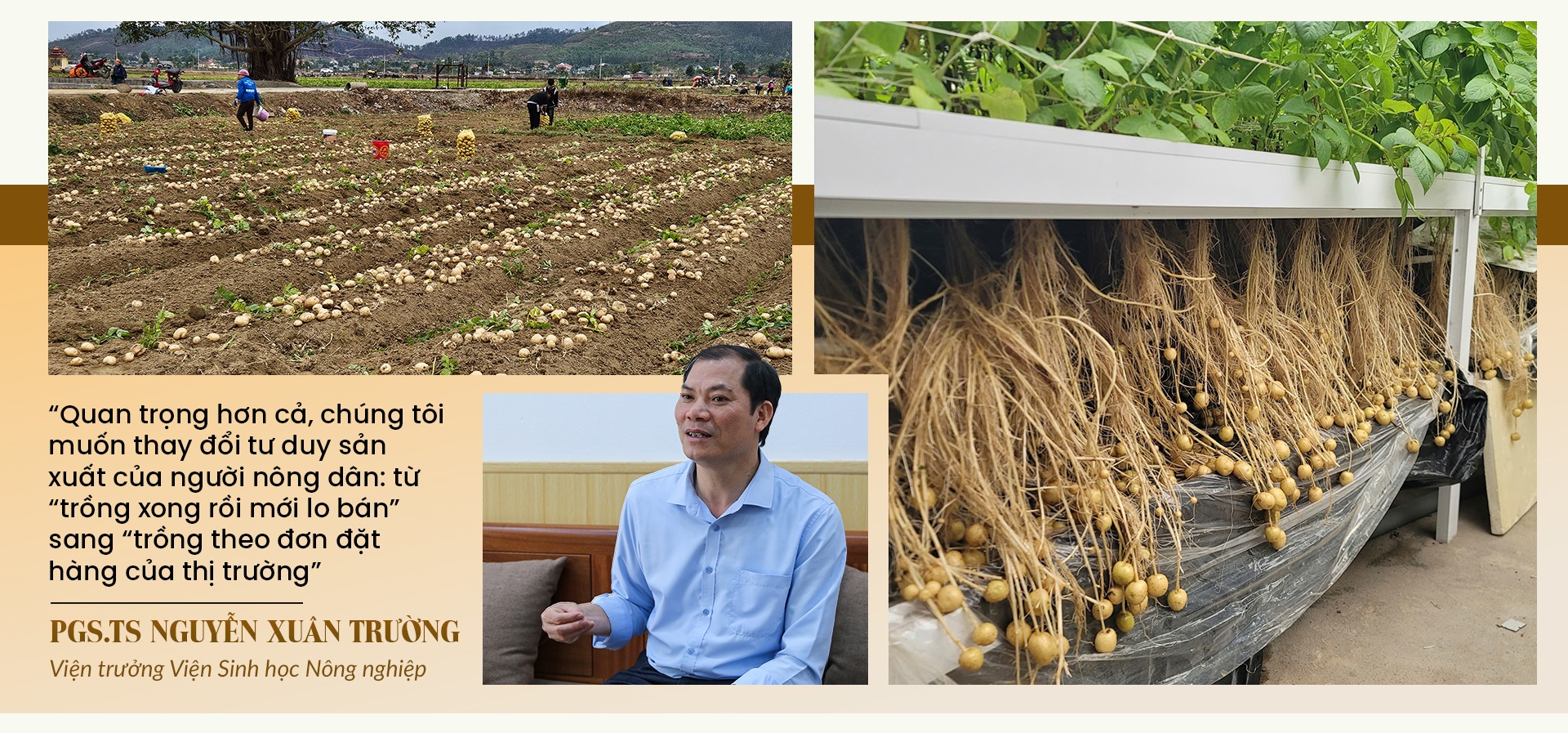
Most importantly, we want to change the farmers' production mindset: from "planting and then worrying about selling" to "planting according to market orders". From small-scale farming to chain farming. From working based on experience to working according to scientific processes.
Potatoes are just a crop - but if they can be done, they will be the clearest proof that: Even forgotten plants can grow into high-tech agricultural products, if properly invested in with science, technology and a desire for innovation.
Thank you for the chat!
Source: https://dantri.com.vn/khoa-hoc/cai-bat-tay-voi-dai-bang-dua-thu-cu-cuu-doi-thanh-nong-san-trieu-usd-20250426192834711.htm








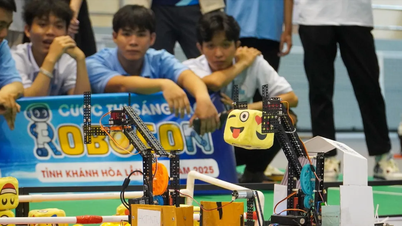



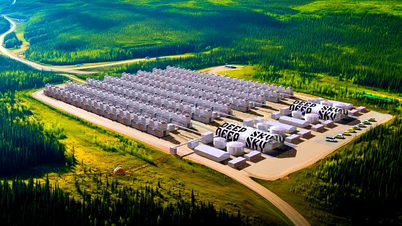

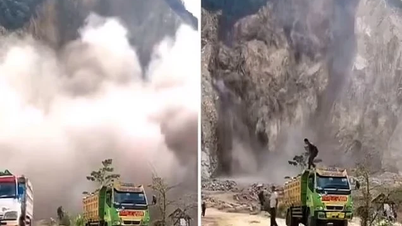

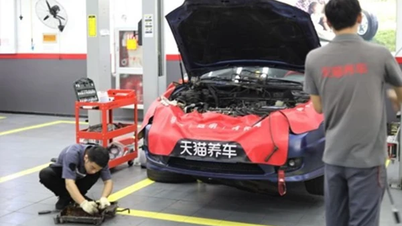






















































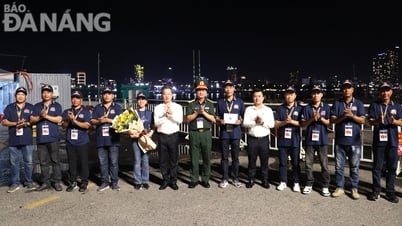











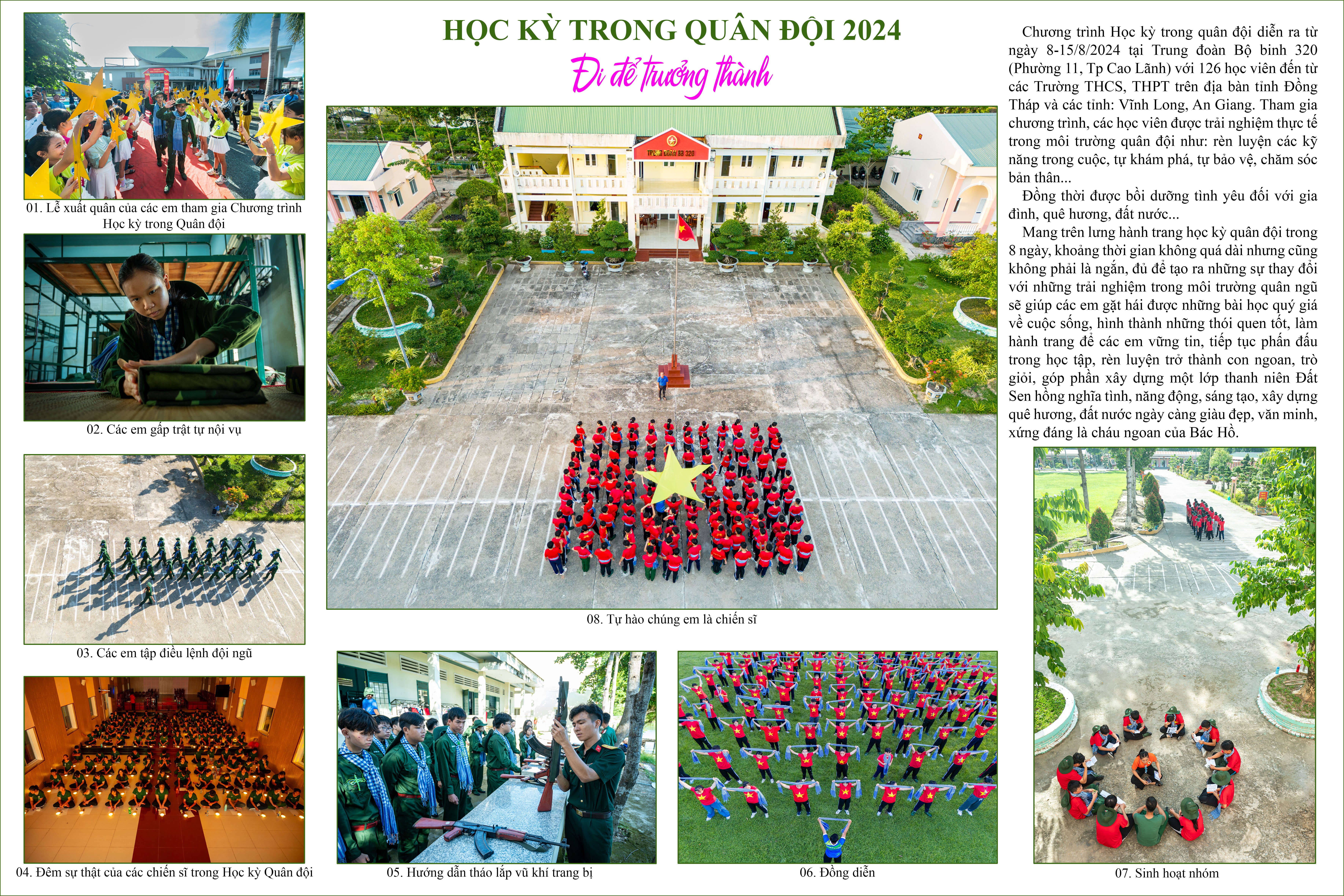



Comment (0)